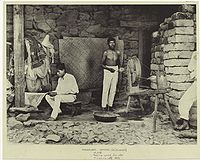- P'urhépecha people
-
The P'urhépecha, normally spelled Purépecha in Spanish and in English and traditionally referred to as Tarascans, are an indigenous people centered in the northwestern region of the Mexican state of Michoacán, principally in the area of the cities of Uruapan and Pátzcuaro. There is an ongoing discussion about which term should be considered as the correct one.[1]
Contents
Territory
In pre-Hispanic times, the Purépecha Indians – also referred to as the Tarascan Indians – occupied most of the state of Michoacán, but they also occupied some of the lower valleys of both Guanajuato and Jalisco. Celaya, Acámbaro, and Yurirapúndaro were all in Purépecha territory.
History
The Tarascan state was one of the pre-Columbian civilizations of Mesoamerica. Their capital city was Tzintzuntzan. Tarascan architecture is noted for step pyramids in the shape of the letter "T". Pre-Columbian P'urhépecha artisans made feather mosaics making extensive use of hummingbird feathers which were a highly regarded luxury good throughout the region. The P'urhépecha were never conquered by the Aztec Empire, despite several attempts by the Mexica to do so, including a fierce war in 1479. This was probably due to the fact of P'urhépecha's knowledge of metal working, an advantage over the Mexica, and still widely regarded today, in particular their coppersmiths. Even though they were enemies, the Mexica still traded with them, mainly for copper axes. After hearing of the Spanish conquest of the Aztec Empire and having the native population much diminished by an epidemic of smallpox, Tangaxuan II, pledged his allegiance as a vassal of the King of Spain without a fight in 1525. It is believed that the Spanish explorer Cristóbal de Olid, upon arriving in the Kingdom of the Purépecha in present-day Michoacán, probably explored some parts of Guanajuato in the early 1520s. A legend relates of a 16–17 year old Princess Erendira of the P'urhépecha led her people into a fierce war against the Spanish. Using the stolen Spanish horses her people learned to ride into battle. Then in 1529–1530, the forces of Nuño de Guzmán entered Michoacán and some parts of Guanajuato with an army of 500 Spanish soldiers and more than 10,000 Indian warriors. In 1530 the Governor and President of the Primera Audiencia, Nuño de Guzmán, plundered the region and ordered the execution of Tangaxuan II, provoking a chaotic situation and widespread violence. In 1533 the Crown sent to Michoacan the experienced oidor (audiencia judge) and later bishop, Don Vasco de Quiroga, who managed to establish a lasting colonial order. The Spanish took it as their name, for reasons that have been attributed to different, mostly legendary, stories.
Religion
Many traditions live on, including the "Jimbani Uexurhina" or new year that is celebrated on February 1. The celebration has traditional indigenous and Catholic elements. The community lights a fire called the chijpiri jimbani or "new fire" as part of a ceremony that honors the four elements. Mass is also celebrated in the P'urhépecha language, and this is the feast day of "San Jerónimo Purechécuaro." The P'urhépecha calendar, like that of the Aztecs for the counting of days called "Xiuhpohualli," had 18 months of 20 days (veintenas) a year with 5 additional feast days. The new year used to be celebrated on the day that the constellation Orion appeared.
Language
P'urhépecha, previously referred to as "Tarascan", is also often used as a name for the P'urhépecha language which is still spoken by more than 100,000 people in Michoacán. Recent attempts have been made to introduce the instruction of the language in the local school systems. The P'urhépecha (and more recently some Spanish-speaking Mexicans) refer to themselves as "P'urhépecha". The name "Tarascan" (and its Spanish-language equivalent, "tarasco") comes from the word "tarascue" in their own language, which means indistinctly "father-in-law" or "brother-in-law". The Nahuatl name for the Tarascans was "Michihuàquê" ("those who have fish"), hence the name of the state of Michoacán (Michihuacán).
See also
- Nicolas de Aguilar, Colonial official in New Mexico
- Silvester J. Brito, poet and educator
- Pedro Dimas
- Princess Erendira
- Vasco de Quiroga
References
- ^ Quintanar Hinojosa, Beatriz (February 2008). "Breves". México Desconocido 372: 9. http://www.mexicodesconocido.com.mx.
External links
- P'urhépecha WEB Page and Community
- P'urhépecha Literature
- Beautiful P'urhépecha women
- P'urhépecha mother with her son
- Learn about archaeological research with a P'urhépecha Community
- Chap. 9: The Twilight of the Gods: The Arrival of the Purépecha (Cycles of the Sun, Mysteries of the Moon; includes area map)
Categories:- Mesoamerican cultures
- Indigenous peoples in Mexico
Wikimedia Foundation. 2010.


